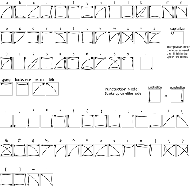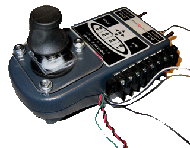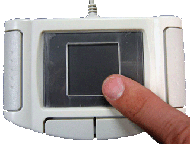Jacob O. Wobbrock and Brad A. Myers
Human-Computer Interaction Institute,
Carnegie Mellon University
Pittsburgh, PA 15213
ABSTRACT
EdgeWrite is a new design for text entry which yields methods that are accessible to some people with motor impairments or who are in physically destabilizing situations like walking or riding. Important properties of EdgeWrite include ease of learning due to the similarity of its letters to Roman characters, stability of motion due to tracing along physical edges, and simple implementation on a wide variety of input devices. Studies suggest that EdgeWrite works well when implemented for use with a stylus on a handheld device, a joystick on a power wheelchair, or for a touchpad on a desktop computer. A future implementation will explore desktop text entry using a trackball.
KEYWORDS
Text entry, input devices, handheld devices, PDAs, joysticks, touchpads, trackballs.
BACKGROUND
Users with motor impairments place significant physical demands on text entry methods. Tremor, spasm, poor coordination, low strength, and rapid fatigue make it difficult to enter text with a QWERTY keyboard or PDA stylus (1) . Tremor and fatigue make it difficult or impossible for some people to draw character forms recognizable by a text entry system like Graffiti, or to select characters on the tiny stylus keyboards of some devices. As small devices proliferate in an aging population, the number of users with motor impairments will only increase. But although work exists on accessible text entry for desktops, little work exists on accessible text entry for handhelds.
Even on desktops, there is still a need for accessible text entry. Many people who need adaptations for text entry do not use them because of cost, complexity, and maintenance (2) . If we had a text entry technique that could be used with standard input devices, cost could be lowered and the need for intervention reduced. In addition, motor-impaired users often need to switch among devices, distributing strain and fatigue over different muscles. Thus, if the same technique could be used on different devices, learning would be eased when transitioning from one device to the next. People who use power wheelchairs often need assistance moving their hands to computer input devices. An integrated text entry and mouse control solution for desktop computers that works with the joystick or touchpad already being used to control the wheelchair would be desirable (3) .
Meanwhile, able-bodied users incur “situational impairments” (4) when using small mobile devices. The spatial constraints of small devices necessitate the use of compact (if not cramped) input techniques demanding accurate movement and careful control. These demands are intensified while walking or riding, since “on the go” use can reduce visibility, divide attention, and impair physical stability. But unfortunately, most mobile text entry methods are not sufficiently tactile or physically stable to be accessible while in motion. The need for physical stability, tactility, accuracy and control felt by “on the go” text entry users is thus not unlike the need felt by motor-impaired text entry users. An accessible design for text entry that benefits one group may therefore benefit the other.
RESEARCH QUESTION
In this work we are asking whether the EdgeWrite design for accessible text entry can (a) be effective for people with some kinds of motor disabilities for desktop and PDA text entry, (b) be robust in its performance across a wide range of input devices, and (c) be useful for able-bodied users “on the go.”
APPROACH
 |
|---|
EdgeWrite is a unistroke input technique like Palm OS Graffiti . Unlike Graffiti, however, EdgeWrite relies on physical edges and corners to provide stability during motion. A user moves his or her stylus, finger, or joystick along the physical edges and into the corners of a square bounding the input area (Figure 1). Recognition does not depend on the whole path of motion, but on the order corners are hit. This means that moderate wiggle and tremor do not deter good recognition. It also means that to add a custom gesture, a user needs only to perform it once, indicating the desired order of corner-hits.
 |
|---|
A key design goal for EdgeWrite was to make the characters easy to learn. All of the character strokes are designed to look and feel similar to the way that characters are hand-printed. Figure 2 shows the character chart for current version of the primary character forms in EdgeWrite. In addition, multiple alternate forms exist for nearly every character (not shown). The character forms are a product of a formal guessability study in which we asked 20 subjects to invent their own alphabets with no prior knowledge of an existing design (5) . We then tested the resulting alphabet with other users. After showing them the primary forms, many people discovered and used several of the alternate character forms despite their absence from the chart. Overall, these studies showed that EdgeWrite can be learned in about 15 minutes, comparable to the time needed to learn Graffiti.
STUDIES
 |
|---|
Our first study with EdgeWrite used the stylus version on a Palm device (Figure 1). First, we had 10 able-bodied users either try Graffiti or EdgeWrite to help assess its speed and accuracy and to validate its design (1) . There was no statistical significant difference in speed of entry (F 1,152=.02, n.s.), but EdgeWrite was over18% more accurate (F 1,56=9.32, p<.02). Encouraged by these results, we then tested four subjects with motor impairments. With so few subjects, we could not evaluate statistical significance, but the results were quite dramatic. Subject 1 was a middle-aged woman with Parkinson’s Disease and severe tremor. Out of 72 letters attempted with Graffiti, only 22 were correctly recognized (31%). However, with EdgeWrite, 68 of 72 were correct (94%). Two other subjects had Cerebral Palsy. One entered a target sentence without errors in EdgeWrite, but had 8 errors with Graffiti. The other left 2 errors with Graffiti but none with EdgeWrite. When switching to EdgeWrite from Graffiti, she exclaimed, “This is a lot easier than before. Much easier, my goodness.” Finally, another user had Muscular Dystrophy with a small baseline tremor. Using Graffiti, he was unable to make b, d, and f after multiple tries and gave up on them. Using EdgeWrite, there were no letters that he could not make. In entering a sentence, he left 3 errors with Graffiti but none with EdgeWrite.
 |
|---|
In another study, we implemented a version of EdgeWrite in C++ for the Everest & Jennings 1706-5020 power wheelchair joystick, which was removed from its chair (Figure 3), and in C# for a Synaptics touchpad (6) (Figure 4). We compared EdgeWrite on each of these devices to the on-screen WiVik keyboard. We improved and tested the three techniques that we evaluated with the help of 7 power wheelchair users, six with Cerebral Palsy one with Multiple Sclerosis. All but one of them used a conventional QWERTY keyboard for text input, but all of them said that they could only do so for less than one hour before becoming fatigued. For speed, touchpad EdgeWrite was fastest on average at 1.00 words per minute (WPM). Joystick WiVik was second at 0.84 WPM. Joystick EdgeWrite was third at 0.77 WPM. The questionnaire results showed that, of the 3 methods, participants felt touchpad EdgeWrite was easiest to use, easiest to learn, fastest, most accurate, most enjoyable, most comfortable, and most liked overall. Participants rated joystick WiVik second in all of these categories, and joystick EdgeWrite third (6) . We are in discussions with a company that makes wheelchair controls about possibly licensing EdgeWrite as a commercial wheelchair text entry technique.
FUTURE WORK AND CONCLUSIONS
Although EdgeWrite has already has been shown to be effective for some people with motor disabilities, we have much work we still want to do. Plans include a stroke-based method for quickly accessing word completions, further studies to characterize the skills of people for which EdgeWrite is effective, and designs and studies of EdgeWrite as a technique for text entry on mobile phones for able-bodied people while walking. In the meantime, the stylus version for Palm PDAs can be downloaded from our web site at http://www.edgewrite.com.
REFERENCES
- Wobbrock, J.O., Myers, B.A., &Kembel, J. (2003). Edgewrite: A Stylus-Based Text Entry Method Designed for High Accuracy and Stability of Motion, in UIST'03: CHI Letters: ACM Symposium on User Interface Software and Technology,. Vancouver, British Columbia, Canada: ACM Press. pp. 61-70.
- Fichten, C.S., Barile, M., Asuncion, J.V., &Fossey, M.E. (2000). What Government, Agencies, and Organizations Can Do to Improve Access to Computers for Postsecondary Students with Disabilities: Recommendations Based on Canadian Empirical Data. International Journal of Rehabilitation Research. 23(3): pp. 191-199.
- Guerette, P. & Sumi, E. (1994). Integrating Control of Multiple Assistive Devices: A Retrospective Review. Assistive Technology. 6(1): pp. 67-76.
- Sears, A., Lin, M., Jacko, J., &Xiao, Y. (2003). When Computers Fade: Pervasive Computing and Situationally-Induced Impairments and Disabilities, in HCI International 2003. Elsevier. pp. 1298-1302.
- Wobbrock, J.O., Aung, H.H., Rothrock, B., &Myers, B.A. (2005). Maximizing the Guessability of Symbolic Input, Submitted for Publication.
- Wobbrock, J.O., Myers, B.A., Aung, H.H., &LoPresti, E.F. (2004). Text Entry from Power Wheelchairs: Edgewrite for Joysticks and Touchpads, in Proceedings of the ACM SIGACCESS Conference on Computers and Accessibility (ASSETS '04). Atlanta, GA: ACM Press. pp. 110-117. Winner, Best Paper Award.